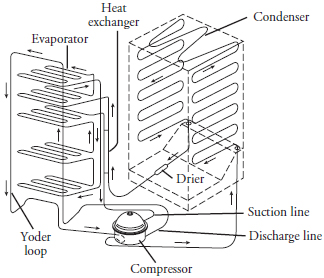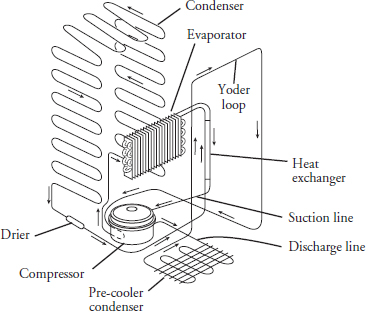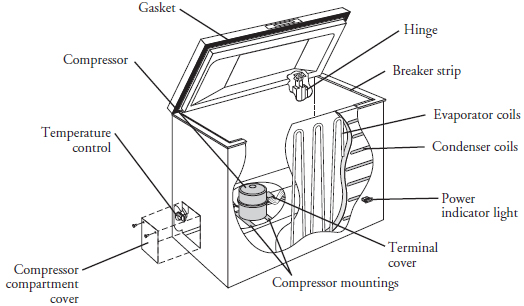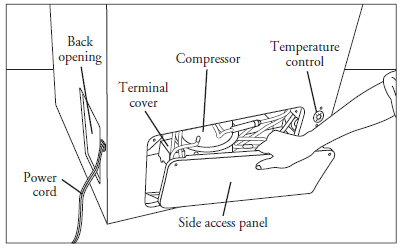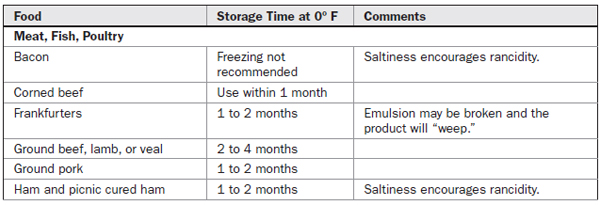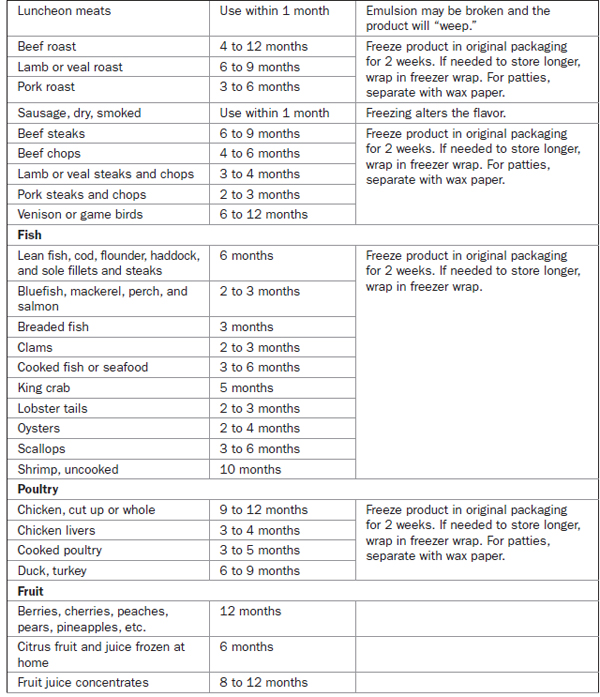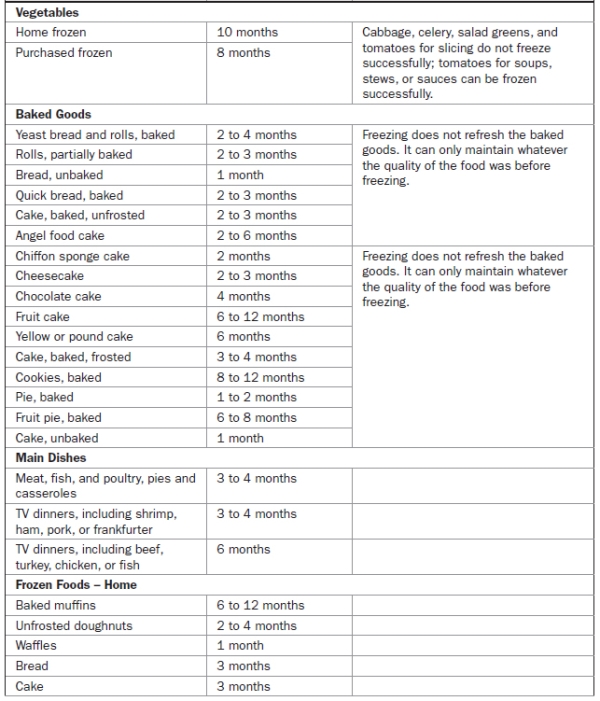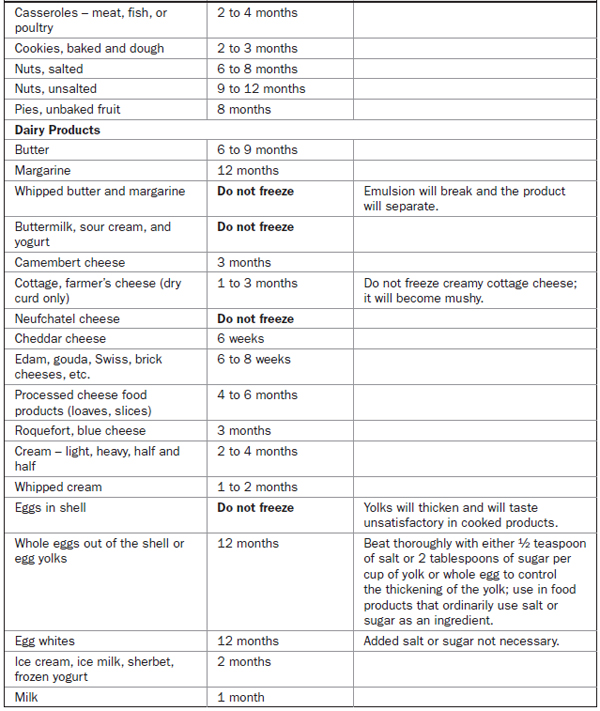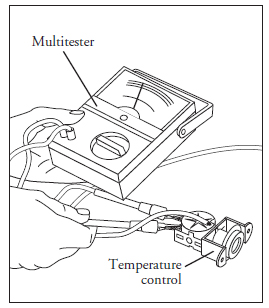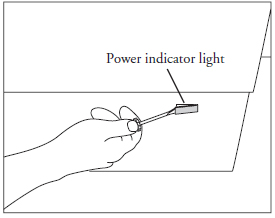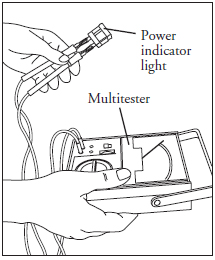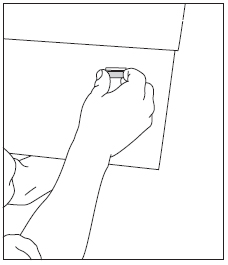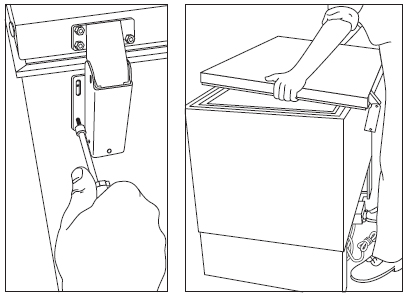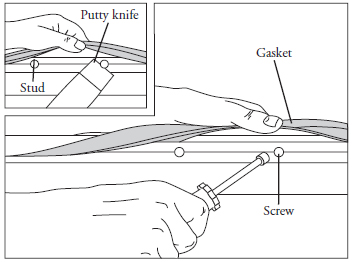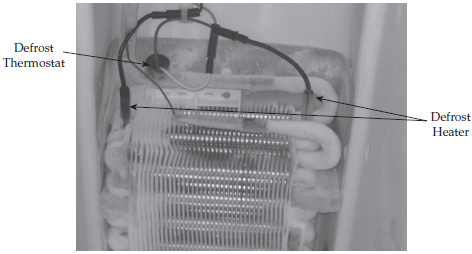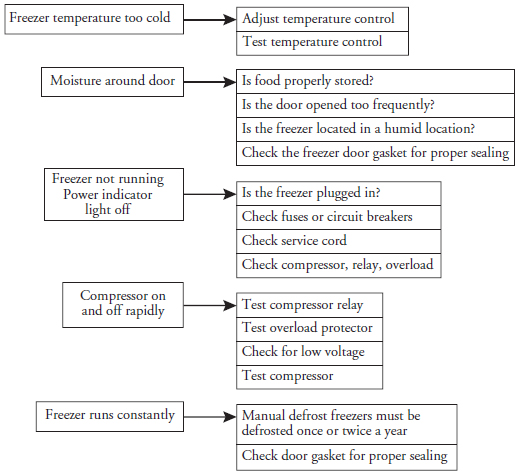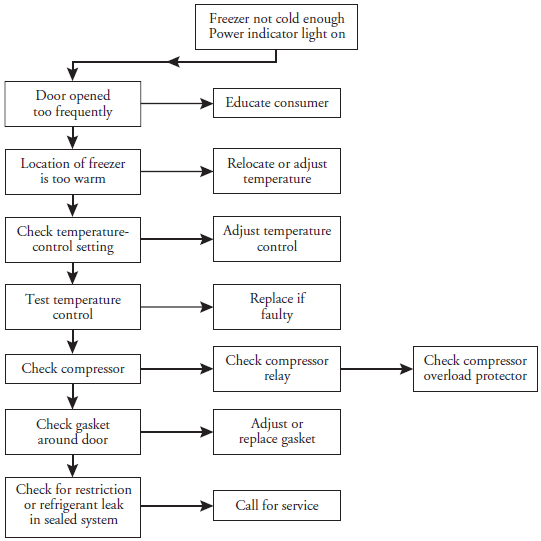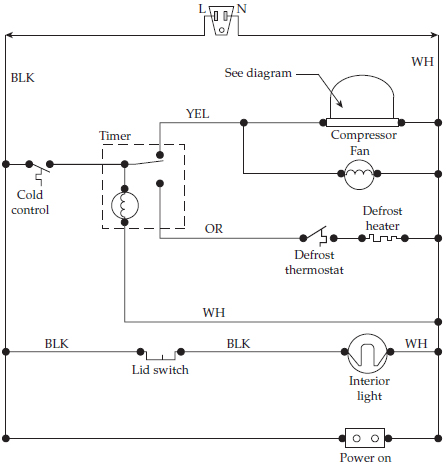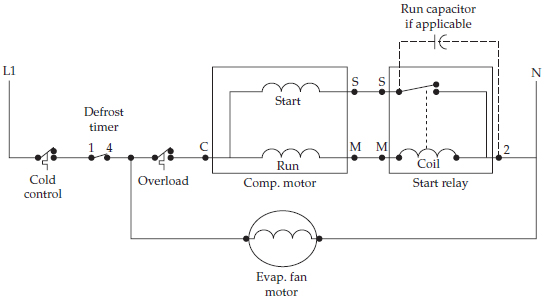26
CHAPTER
Freezers
Freezers are conveniences for people who have very large families or for people who do not frequent the supermarket. They are especially useful in homes with smaller refrigerators or refrigerators having only an ice cube tray compartment. Home freezers come in chest and upright models. Two designs of upright models are available on the market today: manual defrost and automatic defrost. Home freezers are available with wire shelves and baskets, and with storage shelves on the doors in upright models.
The sealed system in the freezer operates the same as the refrigerator/freezer models (see Chapter 25). The only difference is temperature. The domestic freezer operates at a colder temperature. The reason for colder temperatures is to maintain food preservation for a longer period of time.
This chapter covers the electrical components only and how to diagnose the sealed system. The actual repair or replacement of any sealed-system component is not included in this chapter. It is recommended that you acquire refrigerant certification (or call an authorized service company) to repair or replace any sealed-system component. The refrigerant in the sealed system must be recovered properly according to Environmental Protection Agency (EPA) guidelines.
Upright Freezers
Upright freezers are similar to refrigerator/freezers in design and operation. They share some of the same features:
• Fan motors
• Compressor
• Automatic defrost system
• Door gasket
• Thermostat
• Interior lighting
On manual-defrost models,1 the evaporator coils are the shelves inside the cabinet. Figure 26-1 illustrates the refrigerant flow on this type of manually defrosted upright freezer. The condenser coils are embedded between the cabinet liners and are secured to the inside wall of the outer cabinet. This provides for even heat removal and it eliminates the need for a condenser fan motor.
FIGURE 26-1 Refrigerant flow of an upright freezer with manual defrost.
Automatic-defrost models2 use a fan motor to circulate the air inside the cabinet through air ducts. The evaporator coil is mounted on the inside back wall of the inner liner. Figure 26-2 illustrates the airflow pattern in an upright automatic-defrost freezer. Figure 26-3 illustrates the refrigerant flow in this type of upright freezer.
FIGURE 26-2 The airflow pattern of an upright automatic-defrost freezer.
FIGURE 26-3 The refrigerant flow of an upright automatic-defrost freezer.
To diagnose and repair the upright freezer, consult the troubleshooting and the repair procedures sections of this chapter.
Chest Freezers
The chest freezer (Figure 26-4) has the evaporator coils and the condenser coils embedded between the inner liner and the outer cabinet. These coils are inaccessible for replacement or repair if a refrigerant leak occurs. The differences between the upright freezer and the chest freezer are:
FIGURE 26-4 The component location of a chest freezer.
• Door hinges.
• Gasket.
• Location and access of temperature controls.
• Location and access of the compressor, relay, and overload protector. Most models have a power indicator light. This light stays on as long as the freezer is plugged into the wall receptacle. The light alerts the consumer when the power to the freezer is off, but it does not tell you what the temperature is inside the cabinet.
Chest freezers must be defrosted once or twice a year to remove the ice buildup from the inside. To gain access to the components, remove the side access panel (Figure 26-5).
FIGURE 26-5 Removing the side access panel to gain access to the components.
Today some manufacturers have designed chest freezers with an automatic defrost feature similar to upright freezers.
Freezer Storage and Temperatures
Storing and preserving food in a freezer is a great way to maintain the quality, freshness, and nutritional value of food products. The recommended freezer temperature should be 0 degrees Fahrenheit or colder. At this temperature food should last indefinitely if packaged properly. Remember these three rules when packaging foods for freezer storage: wrap tightly, double-wrap the product again, and wrap individual portions separately. To prevent freezer burn, you must wrap food tightly to remove as much air as possible and also double-wrap the food product. When you wrap food in individual portions, you do not have to thaw out a large amount of food. You just take out what you need for that meal.
Maintaining a food’s quality depends on several factors: the quality of the raw product, the procedures used during processing, the way the food is stored, and the length of storage. The recommended storage time takes these factors into consideration.
Table 26-1 depicts a storage chart for various types of food products. Also, I recommend that dates be placed on food products to protect the consumer from eating spoiled or outdated food.
TABLE 26-1 Appropriate Freezing Periods for Various Types of Foods
Safety First
Any person who cannot use basic tools or follow written instructions should not attempt to install, maintain, or repair any freezers. Any improper installation, preventive maintenance, or repairs could create a risk of personal injury or property damage.
If you do not fully understand the installation, preventive maintenance, or repair procedures in this chapter, or if you doubt your ability to complete the task on your freezer, please call your service manager.
Before continuing, take a moment to refresh your memory on the safety procedures in Chapter 2.
Freezers in General
Much of the troubleshooting information in this chapter covers freezers in general, rather than specific models, in order to present a broad overview of service techniques. The illustrations in this chapter are for demonstration purposes only, to clarify the description of how to service these appliances. They in no way reflect a particular brand’s reliability.
Step-by-Step Troubleshooting by Symptom Diagnosis
When servicing an appliance, don’t overlook the simple things that might be causing the problem. Step-by-step troubleshooting by symptom diagnosis is based on diagnosing malfunctions, with possible causes arranged into categories relating to the operation of the freezer. This section is intended only to serve as a checklist to aid you in diagnosing a problem. Look at the symptom that best describes the problem you are experiencing with the freezer, and then correct the problem.
The Freezer Does Not Operate
• Check and see if the freezer is plugged in.
• Check to ensure that the freezer is not plugged into a circuit that has ground fault interrupt.
• Check voltage at receptacle.
• Check circuit breakers and/or fuses.
• Check the temperature controls. Are they off?
Compressor Will Not Run
• Is there voltage at the wall receptacle? Check this with the voltmeter.
• Check for loose electrical connections.
• Is the condenser coil dirty? A dirty condenser coil will overheat the compressor.
• Check the condenser fan motor.
• Test the cold control for continuity.
• Test the compressor, the relay, and the overload switch.
• Check and see if the freezer is in the defrost mode.
Compressor Kicks Out on Overload
• Check for high or low voltage when the compressor tries to start. High voltage will overheat the compressor. Low voltage will try to run the compressor with the start winding. A compressor is designed to start and run within a 10 percent tolerance of the rated voltage.
• Test the capacitor. A shorted or open capacitor will overheat the compressor.
• Test the compressor relay.
• Test the overload for continuity.
• Test the compressor windings for a short.
Freezer Is Too Warm
• Check for restricted air circulation around the condenser coil.
• Check the location of the freezer.
• Check the door gaskets for proper sealing.
• Check the defrost heaters. Use a clamp-on ammeter (or wattmeter) to test the heaters if they are coming on when the refrigeration cycle is running.
• Check the cold control setting.
• Check the compressor. Is it operating properly?
• Is the evaporator fan running?
• Check the air duct for restriction.
• Check for a leaking air duct.
• Check the evaporator coil for excessive frost buildup.
• Check the defrost cycle. Is it working properly?
Freezer Is Too Noisy
• Check for loose parts.
• Check for rattling pipes.
• Check the fan assembly the evaporator, and the condenser.
• Check the compressor.
• If these are normal operational noises, inform the consumer.
• Freezer not properly leveled.
• Check the floor—it may not be structurally sound.
Sweating on the Outside of the Cabinet
• Check the location of the freezer. If located in an area of high humidity, it will begin to sweat.
• Check for a void in the insulation between the cabinet and the inner liner.
• On older models, check for wet insulation.
• Check for suction line or any low-side tubing touching the cabinet.
• Check for water leaks from the ice maker.
• Check for a kinked, misaligned, or blocked drain system.
• Check the defrost drain pan for misalignment or for leaking cracks.
• Are the doors aligned and sealing properly?
Incomplete Defrosting of the Evaporator Coil or High Temperature During the Defrost Cycle
• Test the defrost thermostat.
• Check for loose wiring in the defrost electrical circuit.
• Test the defrost timer for continuity.
• Test for defective defrost heaters.
Odor in Cabinet
• Check for spoiling food in the cabinet.
• Check the defrost water drain system.
• Check the defrost heaters.
Excessive Frost Buildup on Evaporator Coil
• Check the defrost cycle.
• Check for loose wiring.
• Is the heater making contact with the evaporator coil?
• Check for proper door alignment.
• Check the door gaskets.
Freezer Run Time Is Too Long
• Check the thermostat setting.
• Check for excessive loading of unfrozen food.
• Check for incorrect wiring.
• Room or outside weather is too hot.
• Freezer has been recently disconnected for a period of time. Freezers require a minimum of four hours to cool down.
• Check for large amounts of warm water or hot food that have been stored in the freezer recently.
• Freezer lid open too long or too frequently. Advise consumer.
• Check the temperature (cold) control; it might be set too cold.
• Check that the freezer lid/door gasket is not worn, dirty, cracked, or poorly fitted. Clean or change gasket.
Temperature in the Freezer Is Higher Than Normal
• Check the thermostat for proper temperature calibration.
• Check the temperature (cold) control. Is it set too warm?
• Test evaporator fan motor and blade.
• Check the defrost timer.
• Check the lid or door. Is it open too long or too frequently?
• Check for excessive loading of unfrozen food.
• Check door gasket for proper sealing.
• Check the freezer and see if it has been disconnected for a period of time.
Temperature Inside Freezer Is Too Cold
• Check the temperature (cold) control. Reset the control to the correct temperature setting.
Freezer Runs Excessively or Continuously
• Check if the interior lights are staying on continuously.
• Check condenser coil for air restriction.
• Check door gaskets.
• On models with automatic ice makers, make sure the ice maker is operating properly.
Troubleshooting Sealed-System Problems
If you suspect a sealed-system malfunction, be sure to check all external factors first. These include:
• Thermostats
• Compressor
• Relay and overload on the compressor
• Interior lights
• Evaporator and condenser fans
• Timers
• Refrigerator getting good air circulation
• Food loaded in the freezer properly
• Check if heat exchanger has separated
• Check the wiring harness
After eliminating all of these external factors, you will systematically check the sealed system. This is accomplished by comparing the conditions found in a normally operating freezer. These conditions are:
• Freezer storage temperature
• Wattage
• Condenser temperature
• Evaporator inlet sound (gurgle, hiss, etc.)
• Evaporator frost pattern
• Pressure equalization time
One thing to keep in mind is that no single indicator is conclusive proof that a particular sealed-system problem exists. Rather, it is a combination of findings that must be used to definitively pinpoint the exact problem (see Chapter 25).
Repair Procedures
Each repair procedure is a complete inspection and repair process for a single freezer component. It contains the information you need to test the components and replace them, if necessary.
Any person who cannot use basic tools should not attempt to install, maintain, or repair any freezer. Any improper installation, preventative maintenance, or repairs will create a risk of personal injury, as well as property damage. Call the service manager if installation, preventative maintenance, or the repair procedure is not fully understood.
Thermostat (Cold Control)
The thermostat (cold control) is located in the freezer compartment in an upright freezer or in the bottom compartment in a chest type model (Figure 26-4). The cold control maintains the temperature in the freezer. It turns the compressor and fans on and off at preset temperature settings.
The typical complaints associated with failure of the thermostat (cold control) are:
• The freezer is not cold enough.
• The freezer is too cold.
• The freezer runs all the time.
• The freezer doesn’t run at all.
To handle these problems, perform the following steps:
1. Verify the complaint. Verify the complaint by checking the control setting. Turn the control off and on again to see if the freezer starts up. Is the power indicator light on? If the freezer will not power up, locate the technical data sheet behind the control panel or cabinet for diagnostics information. On some models you will need the actual service manual for the model you are working on to properly diagnose the freezer.
2. Check for external factors. You must check for external factors not associated with the appliance. Is the appliance installed properly? Explain to the user how to set the controls. The voltage at the receptacle is between 108 volts and 132 volts during a load on the circuit. Do you have the correct polarity? (See Chapter 6.)
3. Disconnect the electricity. Before working on the freezer, disconnect the electricity. This can be done by pulling the plug from the receptacle. Or disconnect the electricity at the fuse panel or at the circuit breaker panel. Turn off the electricity.
WARNING Some diagnostic tests will require you to test the components with the power turned on. On some models, when you disassemble the control panel, you can position it in such a way that the wiring will not make contact with metal. This will allow you to test the components without electrical mishaps.
4. Gain access to the thermostat. To access the thermostat, remove the access panel (see Figure 26-5). Next, remove the two screws that secure the control. Remove the wires from the terminals. The capillary tube is inserted into a channel. Do not remove capillary tube yet. Test the control first.
5. Test the thermostat. To test the thermostat, place the ohmmeter probes on the terminals (Figure 26-6). Set the range scale on R x 1, and test for continuity. With the control set in the “off” position, you should not read continuity. When the control is set to the highest position, you should read continuity. If the thermostat is good, the problem must be elsewhere.
FIGURE 26-6 Testing the thermostat with a multitester with the range set on the ohms scale. If you read no continuity, replace the thermostat.
6. Remove the thermostat. With the thermostat control housing already removed, the capillary tube must now be removed. Remove the capillary tube from the channel.
7. Install a new thermostat. To install the new thermostat, just reverse the order of disassembly, and reassemble. Then test the control. Remember to reinstall the capillary tube in the same location from which it was removed. Be careful not to kink the tube. If you do, the freezer will not work properly.
Power Indicator Light
The power indicator light lets the consumer know that the freezer is plugged into the receptacle and voltage is present.
The typical complaints associated with the failure of the power indicator light are:
• The light is not on.
• The light flickers.
• The light is dim.
To handle these problems, perform the following steps:
1. Verify the complaint. Verify the complaint by checking if the freezer is plugged into the wall receptacle. Is the power indicator light on? If the freezer will not power up, locate the technical data sheet behind the control panel or cabinet for diagnostics information. On some models you will need the actual service manual for the model you are working on to properly diagnose the freezer.
2. Check for external factors. You must check for external factors not associated with the appliance. Is the appliance installed properly? Check the voltage to the freezer. The voltage at the receptacle is between 108 volts and 132 volts during a load on the circuit. Do you have the correct polarity? (See Chapter 6.)
3. Disconnect the electricity. Before working on the freezer, disconnect the electricity. This can be done by pulling the plug from the receptacle. Or disconnect the electricity at the fuse panel or at the circuit breaker panel. Turn off the electricity.
WARNING Some diagnostic tests will require you to test the components with the power turned on. On some models, when you disassemble the control panel, you can position it in such a way that the wiring will not make contact with metal. This will allow you to test the components without electrical mishaps.
4. Gain access to the power indicator light. To access the power indicator light, use a screwdriver to pry out the power indicator light from the front of the freezer cabinet. Next, remove the wires from the indicator light (Figure 26-7).
FIGURE 26-7 Pry gently to remove the power indicator light. Be careful not to scratch the cabinet.
5. Test the power indicator light. To test the power indicator light, place the ohmmeter probes on its terminals (Figure 26-8). Set the range scale on R x 1, and test for continuity. The meter should show continuity; if not, replace the component.
FIGURE 26-8 Testing the power indicator light.
6. Install a new power indicator light. To install the new power indicator light, just reverse the order of disassembly, and reassemble (Figure 26-9). Then test the control.
FIGURE 26-9 When installing the power indicator light, you must first reconnect the wires and then insert the light in the cabinet.
Gasket
The door gasket is mounted to the lid on a chest freezer and mounted on the door of an upright model. The door gasket consists of a vinyl rubber gasket with a magnet. The magnet helps secure the door closed to keep the cold inside the box and the heat out.
The typical complaints associated with failure of the door gasket are:
• Sweating inside and/or outside of the cabinet.
• Temperatures inside the cabinet are warmer than normal.
• Ice is forming on the freezer walls.
• Door gasket not maintained properly.
To handle these problems, perform the following steps:
1. Verify the complaint. Verify the complaint by checking the door gasket for proper sealing and alignment. Inspect the gaskets for any damage.
2. Check for external factors. You must check for external factors not associated with the appliance. Is the appliance installed properly?
3. Disconnect the electricity. Before working on the refrigerator/freezer, disconnect the electricity. This can be done by pulling the plug from the receptacle. Or disconnect the electricity at the fuse panel or at the circuit breaker panel. Turn off the electricity.
4. Test the door gasket. To test the gasket for proper sealing, take a dollar bill and place it between the gasket and the flange of the outer cabinet. Pull on the dollar bill. When pulling on the dollar bill, you should feel some tension as the gasket and flange grip the bill. Repeat this test in other areas where you suspect problems with the gasket. If the gasket fails this test, the next step is to replace the gasket.
5. Gain access to the door gasket. To access the door gasket, the door must be removed (Figure 26-10). Turn the door over on its back.
FIGURE 26-10 Removing the screws from the hinges and lifting the door from the freezer.
6. Remove the gasket. Remove the gasket, either by prying the studs out or by removing the screws (Figure 26-11).
FIGURE 26-11 Removing the studs (inset). On some models, you must remove the screws that secure the gasket to the door.
7. Install a new door gasket. Before installing the new gasket, soak it in warm water for 15 to 20 minutes. This will make the gasket soft and easier to install. Starting at either top corner, insert the flange of the gasket behind the retaining strip and/or door liner. Proceed all the way around the door. When the gasket is in place, begin to tighten the screws slightly all around the door or reinstall the studs. If the gasket is distorted, or if it has wrinkles in it, use a hair dryer to heat the gasket and mold it to its original form. Then be sure the gasket seats against the flange properly. Next, check the gap between the door and the cabinet; adjust it, if necessary (see step 4).
Defrost Timer (Automatic Defrost Models)
The purpose of the defrost timer is to regulate the frequency of the defrost cycles and their duration. The defrost timer also limits the maximum amount of time that the defrost heater can be energized. There are two types of configurations used in a mechanical timer. They are continuous run and cumulative run. The difference between the two is the way that the timer motor is energized. The continuous run timer will be energized anytime when the refrigerator is plugged in, and the cumulative run timer is energized when the cold control is calling for cooling and the compressor is running.
The typical complaints associated with failure of the defrost timer are:
• The freezer does not defrost.
• The storage temperature in the cabinet is too warm.
• The compressor will not run.
To handle these problems, perform the following steps:
1. Verify the complaint. Verify the complaint by asking the customer to describe what the freezer is doing or did. If the freezer will not power up, locate the technical data sheet behind the control panel or cabinet for diagnostics information. On some models you will need the actual service manual for the model you are working on to properly diagnose the freezer.
2. Check for external factors. You must check for external factors not associated with the appliance. Is the appliance installed properly? Is the door aligned properly? The voltage at the receptacle is between 108 volts and 132 volts during a load on the circuit. Do you have the correct polarity? (See Chapter 6.)
3. Disconnect the electricity. Before working on the freezer, disconnect the electricity to the appliance. This can be done by pulling the plug from the receptacle. Or disconnect the electricity at the fuse panel or at the circuit breaker panel. Turn off the electricity.
WARNING Some diagnostic tests will require you to test the components with the power turned on. When you disassemble the control panel, you can position it in such a way that the wiring will not make contact with metal. This will allow you to test the components without electrical mishaps.
4. Gain access to the defrost timer. To access the defrost timer, you must first locate it. On some models, the defrost timer is located on the bottom, behind the toe plate; or it might be behind the temperature control housing, in the freezer section (Figure 25-14); or it might be in the back of the freezer, behind the rear leg (Figure 25-15) or in the compressor compartment.
5. Remove the defrost timer. In order to test the defrost timer, it must be removed from its mounting position. Remove the two mounting screws from the defrost timer (see Figure 25-15). Next, remove the wire harness plug from the defrost timer (Figure 25-16).
6.
Test the defrost timer. To test the defrost timer, place a screwdriver in the timer cam slot (
Figure 25-17), and turn it clockwise until you hear the first “snap.” The defrost timer is now in the defrost cycle. At this point, you must read the wiring diagram to determine which numbered terminals are for the defrost circuit. For the purpose of demonstrating how to check for continuity of the switch contacts,
Figure 25-18a illustrates the internal components of this sample timer. Set the ohmmeter scale on R × 1, and place the probes on the terminals marked 2 and 3 (
Figure 25-19). You should measure continuity. Next, rotate the timer cam until you hear the second “snap.” The meter will show no continuity, indicating that the defrost cycle is over and that the refrigeration cycle begins.
Now place the meter probes on the terminals marked 3 and 4. The ohmmeter will show continuity, indicating the refrigeration cycle is activated. Turn the timer cam once again, until you hear the first “snap.” The meter will show no continuity. At no time should there be continuity between terminals 2 and 4. (If so, the switch contacts are burned and welded together and the defrost timer must be replaced.) If the defrost timer passes this portion of the test, you must determine if the timer mechanism is functioning. Place the ohmmeter probes on the timer motor leads and read the resistance. The resistance can be between 800 and 4000 ohms, depending on the type of timer used by the manufacturer. If you are unable to read resistance, the timer motor is defective.
If the defrost timer passes this portion of the test, rotate the timer cam until you hear the first “snap.” Advance the timer cam again, counting the number of clicks until you hear the second “snap.” Write down the number of clicks on a piece of paper. Now rotate the timer cam again until the marks line up (Figure 25-18b), which indicates the beginning of the defrost cycle, and the “snap” is heard. Advance the timer cam and count the clicks until there is one click left before the end of the defrost cycle. Take the timer and reconnect it to the wiring harness (see Figure 25-16). Place the defrost timer on a nonmetallic surface.
Reconnect the voltage supply to the refrigerator/freezer. Note: Be cautious when working with live wires. Avoid getting shocked. Place the ammeter jaws around the wire attached to the number 4 terminal. The meter should indicate no amperage. Next, place the jaws on the number 2 terminal wire. The ammeter should indicate some amperage. Wait for approximately 10 to 15 minutes: you should hear a “snap,” indicating that the timer has completed the defrost cycle. At this point, the ammeter will show no amperage on number 2, but will indicate current flow at number 4. If not, replace the timer.
7. Install a new defrost timer. To install the new defrost timer, just reverse the order of disassembly and reassemble. Remember to reconnect the ground wire to the defrost timer.
Defrost Heater (Automatic Defrost Models)
Manufacturers also use a single-calrod type, radiant heater mounted under the evaporator coil for maximum defrosting of the evaporator coil.
The typical complaints associated with failure of the defrost heater are:
• The freezer temperature is warm.
• The freezer does not defrost.
• Food is spoiling.
• No ice cubes.
To handle these problems, perform the following steps:
1. Verify the complaint. Verify the complaint by asking the customer to describe what the freezer is doing. Is food spoiling? Check the temperature in the compartment. Check for ice buildup on the evaporator cover. If the freezer will not power up, locate the technical data sheet behind the control panel or cabinet for diagnostics information. On some models you will need the actual service manual for the model you are working on to properly diagnose the freezer.
2. Check for external factors. You must check for external factors not associated with the appliance. Is the appliance installed properly? Is there electricity to the freezer? Is the electrical receptacle polarized and properly grounded? The voltage at the receptacle is between 108 volts and 132 volts during a load on the circuit. Do you have the correct polarity? (See Chapter 6.)
3. Disconnect the electricity. Before working on the freezer, disconnect the electricity. This can be done by pulling the plug from the receptacle. Or disconnect the electricity at the fuse panel or at the circuit breaker panel. Turn off the electricity.
WARNING Some diagnostic tests will require you to test the components with the power turned on. When you disassemble the control panel, you can position it in such a way that the wiring will not make contact with metal. This will allow you to test the components without electrical mishaps.
4. Gain access to the defrost heater. To access the defrost heater, the evaporator cover must be removed (see Figure 25-23). Remove the screws that secure the cover in place.
5. Test the defrost heater. A defrost heater should be tested for proper resistance, as indicated on the wiring diagram. To test the defrost heater, remove the wires from the heater terminals. Next, place the probes of the ohmmeter on the heater terminals (Figure 26-12). Set the scale on R x 1. The meter should show resistance. If no reading is indicated, replace the defrost heater.
FIGURE 26-12 Frozen evaporator coil. Test the defrost thermostat first before you defrost the evaporator coil.
6. Remove the defrost heater. To remove the calrod defrost heater, you must first defrost the ice from the evaporator coil. Bend the clips that secure the heater in place and then remove the defrost heater.
7. Install a new defrost heater. To install the new defrost heater, just reverse the order of disassembly and reassemble. When reinstalling any shrouds, grilles, ducts, or gaskets, always position them correctly to ensure the proper airflow through the evaporator and within the compartment of the freezer.
Defrost Thermostat (Automatic Defrost Models)
The defrost thermostat is a bimetal switch installed on the evaporator coil that provides over temperature protection during defrost. The defrost heaters will defrost the evaporator coil within a given time. But, if the evaporator coil is totally defrosted before the time has expired, the defrost thermostat will open up, shutting off the defrost heater to prevent the evaporator coil area from overheating.
The typical complaints associated with failure of the defrost thermostat are:
• The freezer temperature is warm.
• The freezer does not defrost.
• Food is spoiling.
• No ice cubes.
To handle these problems, perform the following steps:
1. Verify the complaint. Verify the complaint by asking the customer to describe what the freezer is doing. Is food spoiling? Check the temperature in the compartment. Check for ice buildup on the evaporator cover. If the freezer will not power up, locate the technical data sheet behind the control panel or cabinet for diagnostics information. On some models you will need the actual service manual for the model you are working on to properly diagnose the freezer.
2. Check for external factors. You must check for external factors not associated with the appliance. Is the appliance installed properly? Is there electricity to the freezer? Is the electrical receptacle polarized and properly grounded? The voltage at the receptacle is between 108 volts and 132 volts during a load on the circuit. Do you have the correct polarity? (See Chapter 6.)
3. Disconnect the electricity. Before working on the freezer, disconnect the electricity. This can be done by pulling the plug from the receptacle. Or disconnect the electricity at the fuse panel or at the circuit breaker panel. Turn off the electricity.
WARNING Some diagnostic tests will require you to test the components with the power turned on. When you disassemble the control panel, you can position it in such a way that the wiring will not make contact with metal. This will allow you to test the components without electrical mishaps.
4. Gain access to the defrost thermostat. To access the defrost thermostat, the evaporator cover must be removed (see Figure 26-12). Remove the screws that secure the cover in place.
5. Test the defrost thermostat. Failure of a defrost thermostat usually results in a frost-blocked evaporator. To test the defrost thermostat, disconnect the wires to isolate the thermostat from the rest of the defrost circuit. Next, place the probes of the ohmmeter on the defrost thermostat wire leads. Set the meter scale on R x 1. The meter will show continuity when the thermostat is either frozen or very cold, indicating the defrost thermostat is good. The defrost thermostat switch contacts close when the temperature is colder than its temperature rating. If no reading is indicated, replace the defrost thermostat. At ambient temperature, you will read no continuity, which will indicate the thermostat might be good.
6. Remove the defrost thermostat. To remove the defrost thermostat, you must remove the hold-down clamp. On some models, the defrost thermostat and clamp are one assembly. On other models, the defrost thermostat clamps around the evaporator tubing. As shown in Figure 26-12, remove this type of defrost thermostat by squeezing in on the clip and lifting the thermostat up.
7. Install a new defrost thermostat. To install the new defrost thermostat, just reverse the order of disassembly and reassemble. Remember to reconnect the wires to the thermostat. When reinstalling any shrouds, grilles, ducts, or gaskets, always position them correctly to ensure the proper airflow through the evaporator and within the compartment of the freezer. On models that have the defrost thermostat attached to the evaporator coil, you must reinstall the defrost thermostat in the same location from which it was removed.
Evaporator Fan Motor (Automatic Defrost Models)
The evaporator fan motor provides air circulation within the freezer cabinet and over the evaporator coil which is located in the freezer compartment of the freezer. One type of motor used in freezers is a shaded pole, single-speed motor that runs on 120 VAC.
The typical complaints associated with failure of the evaporator fan motor are:
• The freezer temperature is warm.
• The evaporator fan motor runs slower than normal.
• The evaporator fan motor does not run at all.
• The evaporator fan motor is noisy.
To handle these problems, perform the following steps:
1. Verify the complaint. Verify the complaint by asking the customer to describe what the freezer is doing or did. Is the evaporator fan motor running? Is it noisy? If the refrigerator will not power up, locate the technical data sheet behind the control panel or cabinet for diagnostics information. On some models you will need the actual service manual for the model you are working on to properly diagnose the freezer.
2. Check for external factors. You must check for external factors not associated with the appliance. Is the appliance installed properly? Is there something hitting the fan blade? Is there electricity to the freezer? Is the electrical receptacle polarized and properly grounded? The voltage at the receptacle is between 108 volts and 132 volts during a load on the circuit. Do you have the correct polarity? (See Chapter 6.)
3. Disconnect the electricity. Before working on the freezer, disconnect the electricity. This can be done by pulling the plug from the receptacle. Or disconnect the electricity at the fuse panel or at the circuit breaker panel. Turn off the electricity.
WARNING Some diagnostic tests will require you to test the components with the power turned on. When you disassemble the control panel, you can position it in such a way that the wiring will not make contact with metal. This will allow you to test the components without electrical mishaps.
4. Gain access to the evaporator fan motor. To access the evaporator fan motor, the evaporator cover must be removed. Remove the screws that secure the cover in place. On some models, the evaporator fan assembly is located on the rear wall of the interior freezer compartment.
5. Test the evaporator fan motor. The shaded-pole, 120 VAC evaporator fan motor should be tested for proper resistance, as indicated on the wiring diagram. To test the evaporator shaded-pole fan motor, remove the wires from the motor terminals. Next, place the probes of the ohmmeter on the motor terminals (Figure 25-22). Set the scale on R x 1. The meter should show resistance. If no reading is indicated, replace the motor. If the fan blade does not spin freely, replace the motor. If the fan motor runs and it is noisy (bad bearings), replace the motor. Also check the motor for grounded windings; if grounded, replace the motor.
6. Remove the evaporator fan motor. To remove the evaporator fan motor, you must first remove the fan blade. On most models, just pull the blade off the motor shaft. Be careful not to break the blade. On other models, the fan blade is held on the motor shaft with screws. Remove the screws. Then remove the screws that secure the fan assembly to the cabinet (Figure 25-23). On some models, you must remove the fan shroud (Figure 25-24) by removing the shroud screws.
7. Install a new evaporator fan motor. To install the new evaporator fan motor, just reverse the order of disassembly and reassemble. When reinstalling the fan blades onto the motor shaft, the fan blades should be positioned on the shaft so that one-third of its depth (approximately 1/4 inch) protrudes through the fan orifice in the direction of airflow. When reinstalling any shrouds, grilles, ducts, or gaskets, always position them correctly to ensure the proper airflow through the evaporator and within the compartment of the freezer. Remember to reconnect the ground wire to the motor. Reconnect the wires to the motor terminals, and test.
Compressor, Relay, and Overload Protector
The compressor (reciprocating or rotary type) is the heart of the vapor compression system. It is used to circulate the refrigerant throughout the sealed system. The relay and overload are attached to the compressor. The relay starts the compressor, and the overload protects the compressor. All three components are located in the machine compartment in the rear or bottom of the freezer. The relay can be either a current or a PTC (positive temperature coefficient) type device. The overload is a bimetal switch that is secured to the outer shell of the compressor.
The typical complaints associated with failure of the compressor are:
• The freezer temperature is warm.
• The freezer does not run at all.
• Food is spoiling.
To handle these problems, perform the following steps:
1. Verify the complaint. Verify the complaint by asking the customer to describe what the refrigerator is doing. If the freezer will not power up, locate the technical data sheet behind the control panel or cabinet for diagnostics information. On some models you will need the actual service manual for the model you are working on to properly diagnose the freezer.
2. Check for external factors. You must check for external factors not associated with the appliance. Is the appliance installed properly? Check for a voltage drop during freezer startup. Is there electricity to the freezer? Is the electrical receptacle polarized and properly grounded? The voltage at the receptacle is between 108 volts and 132 volts during a load on the circuit. Do you have the correct polarity? (See Chapter 6.)
3. Disconnect the electricity. Before working on the freezer, disconnect the electricity. This can be done by pulling the plug from the receptacle. Or disconnect the electricity at the fuse panel or at the circuit breaker panel. Turn off the electricity.
WARNING Some diagnostic tests will require you to test the components with the power turned on. When you disassemble the control panel, you can position it in such a way that the wiring will not make contact with metal. This will allow you to test the components without electrical mishaps.
4. Gain access to the compressor. To access the compressor, pull the freezer out and away from the wall. Remove the back panel, which is located at the bottom of the freezer (Figure 26-5). This will expose the compressor. Next, remove the compressor terminal cover (Figure 25-34) by removing the retaining clip that secures the cover. Remove the terminal cover.
5.
Test the compressor relay. To test the compressor current relay, remove the relay by pulling it off the compressor terminals without twisting it (
Figure 25-35a). Remove the wires from the relay and label them. On the relay body is stamped the word TOP. Hold the relay so that TOP is in the up position.
Next, place the probes of the ohmmeter on the relay terminals marked S and M. Set the meter scale on R × 1. The reading will show no continuity. Then remove the probe from the terminal marked M, and place it on the side terminal marked L. The reading will show no continuity. Now, move the probe from terminal S, and place it on the terminal marked M. The reading will show continuity. With the probes still attached, turn the relay upside down (Figure 25-35b), and perform the same tests. By turning the relay over, the switch contacts in the relay will close. When you retest the relay, you should get the opposite results: You should have continuity between terminals S and M and between S and L; however, the meter will not read continuity between M and L. If the relay fails this test, replace it. The elimination method is the best way to test a PTC relay; you would first test the run capacitor, overload, and then run the compressor with a fused test cord. If all of these components check out okay, replace the relay.
6. Test the overload protector. To test the overload protector, remove the wires from the overload and compressor terminals. Then remove the overload protector from the compressor by removing the retaining clip that secures the overload protector to the compressor (Figure 25-36a). Next, place the probes of the ohmmeter on the overload terminals (Figure 25-36b). Set the meter scale on R × 1. The reading will show continuity. If not, replace the overload protector.
7.
Test the compressor. To test the compressor, remove the relay and the overload protector. This will expose the compressor terminals. The compressor terminals are marked C, S, and R. C indicates the common winding terminal, S indicates the start winding terminal, and R indicates the run winding terminal. (Refer to the actual wiring diagram for the model that you are servicing.) Set the meter scale on R × 1, touch the probes together, and adjust the needle setting to indicate a zero reading. Next, place the probes of the ohmmeter on the terminals marked S and R (
Figure 25-37a). The meter reading will show continuity. Now place the meter probes on the terminals marked C and S. The meter reading will show continuity. Finally, place the meter probes on the terminals marked C and R. The meter reading will show continuity. The total number of ohms measured between S and R is equal to the sum of C to S plus C to R. The compressor should be tested for proper resistance, as indicated on the wiring diagram.
To test the compressor for ground, place one probe on a compressor terminal, and attach the other probe to the compressor housing or any good ground (Figure 25-37b). Set the meter scale to R × 1000. The meter reading will show no continuity. Repeat this for the remaining two terminals. The meter reading will show no continuity. If you get a continuity reading from any of these terminals to ground, the compressor is grounded. Replace it.
8. To replace the overload and relay. To install the new overload or relay, just reverse the order of disassembly and reassemble. Remember to reconnect the wires to the overload or relay.
Diagnostic Charts
The following freezer diagnostic charts will help you to pinpoint the likely causes of the particular problem associated with these appliances (Figures 26-13 and 26-14).
FIGURE 26-13 The diagnostic flowchart.
FIGURE 26-14 The diagnostic flowchart: Freezer not cold enough/power indicator light on.
Freezer Electrical Schematics
The wiring diagrams in this chapter are examples only. You must refer to the actual wiring diagram for the freezer you are servicing. Figures 26-15, 26-16, and 26-17 show a typical wiring schematic and strip circuits for an automatic defrost and manual freezer.
FIGURE 26-15 A typical wiring diagram for an automatic defrost freezer.
FIGURE 26-16 A typical strip circuit for a freezer.
FIGURE 26-17 A typical strip circuit for an automatic defrost freezer.
Endnotes
1. Manual defrost freezers must be defrosted once or twice a year, depending upon usage.
2. Automatic defrost freezers will self-defrost the evaporator coil. The defrost components are the defrost timer, the defrost thermostat, and the defrost heater.
3. If you open up the sealed system, you will void your warranty. The sealed system must be repaired by an authorized service company.
4. If you open up the sealed system, you will void your warranty. The sealed system must be repaired by an authorized service company.
